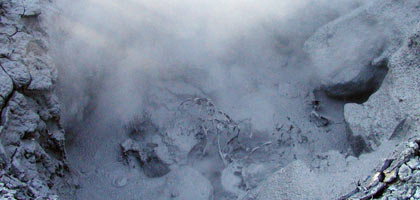| SCRIPPS INSTITUTION OF OCEANOGRAPHY, UCSD |

| the expedition | |
| the science | |
| tools & techniques | |
| japanese life | |
| daily journal | |
| the team | |
|
:: VOLCANOES :: Fuji Hakone Oshima Nii-Jima • Shikinejima Hachijo-Jima Aoga-Shima |
|
|||||||||||||||||||||||||||||||||||||||||||||||||||||||||||||||||||||||||||||||||||||||||||||||||||||||||
Data Interpretation

Once we have measured all the samples back in the laboratory, we will interpret our results. The main questions we want to answer with the data are:
- (1) How much water, carbon dioxide, nitrogen, and other gases are released from the entire IBM arc?
- (2) What are the ultimate sources of these gases - mantle, subducted sediments, subducted oceanic crust or the atmosphere?
- (3) How does the output of volatiles to the atmosphere compare to the input into the subduction zone by subducted sediments and oceanic crust?
Our scientific approach in trying to answer these questions involves:
- (1) Measuring the flux of sulfur dioxide emissions from the volcanoes using our miniDOAS instrument. From the chemistry of the gas samples that we collect, we will be able to calculate the emissions of all the other gas species.
- (2) Using the isotopic composition of carbon (in carbon dioxide) and nitrogen to determine the sources of these gases. Each reservoir - mantle, sediments, and oceanic crust - has a distinct isotopic composition. Nitrogen, in particular, is an excellent tracer gas for subducted sediments that are rich in organic matter. This organic matter has a very distinct nitrogen isotopic composition compared to the Earth's mantle. Using the combination of nitrogen, carbon and helium isotopes and relative abundances we will be able to calculate the relative contributions of the mantle, subducted organic sediments and the subducted oceanic crust to the magmas and to the gases that are emitted to the atmosphere.
- (3) Once we have resolved the contributions and emission rates of the gases from each reservoir, we can compare those results with the input into the subduction zone. In the case of nitrogen, for example, if there is more sedimentary nitrogen subducted than what we measure for the output, then some of this nitrogen may get introduced into the deeper mantle where it can contribute to the chemical composition of the mantle.
If our expedition (sample collection and analyses) is successful, we will be able to address questions that are of fundamental importance to the chemical evolution of the Earth's mantle, the atmosphere and the oceans. The study of the IBM system is complementary to our previous work in Central America where we have addressed similar questions. We hope that by investigating the IBM system, our findings will have global significance.
